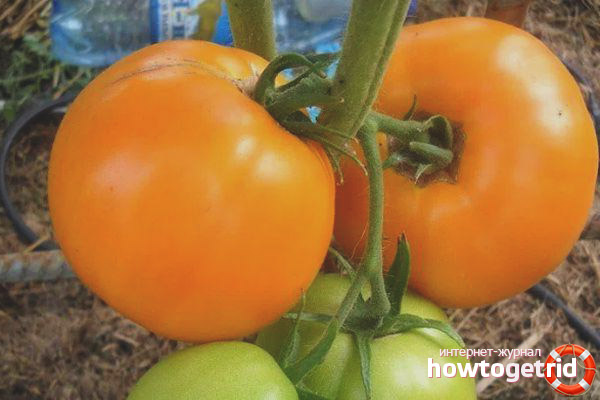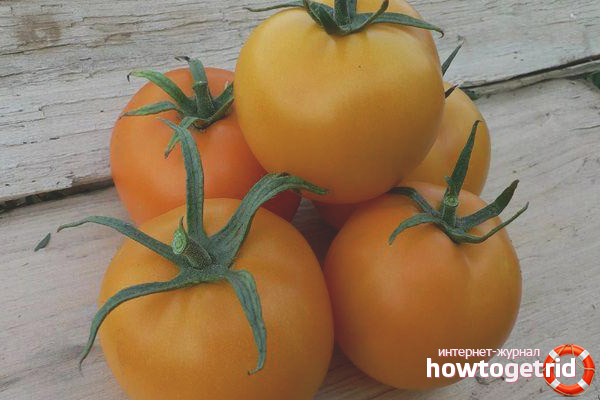The content of the article
The meaty varieties of large tomatoes have always been popular among lovers of this type of vegetable. Among a large variety of varieties, this one deserves attention due to the unusual taste and yellow color of the fruit.
Plant description
The variety belongs to high-yielding mid-season tomatoes, since from the moment of sowing to the full ripening of the first tomatoes it takes from 110 to 120 days. The plant of this variety is indeterminate, not very tall. In height, it rarely grows to a height of more than 1 - 1.5 m. The stems are thin, but strong, medium-branched and medium-leafy. On the stems are small leaves resembling potato tops. During fruit ripening, the plant needs to be tied.
The variety is characterized by high productivity, not capricious, hardy.
Fruit Characteristics
Description:
- Fruits have a flat-round shape, slightly ribbed at the stem.
- The weight of each varies between 150-300 g.
- The color of ripe tomatoes has a rich golden orange or bright yellow hue.
- They have few seed chambers - about four.
- Their skin is thin, but very dense, does not crack.
- When ripe, the fruits acquire a rich smell of tomatoes.
- Inside the tomatoes are fleshy, sugary, reminiscent of honey.
- They taste pleasant, sweet with a slight acidity.
- Pulp sugar level - not more than 5%.
- Due to the taste and aroma, tomato is used in cooking for preparing various dishes and salads, but the size of the fruits does not make it possible to preserve them in banks.
Advantages and disadvantages
The benefits of a variety that make it popular include:
- excellent aroma and taste;
- good presentation;
- high productivity;
- good resistance to cold weather and rain;
- easy tolerance of droughts and hot weather.
The main disadvantage is the condition of good illumination of the area reserved for tomatoes of this variety.
Agricultural technology

Breeders recommend these tomatoes for harvesting in greenhouses. Because it develops worse in some regions, it bears less fruit, if it grows initially not in greenhouses or greenhouses.
Sowing seeds is carried out approximately 2 months before transplanting into the ground. This usually occurs in late March - early April. Sow seeds in a slightly compacted soil prepared for this purpose, deepening them by a centimeter. Sprinkle the crops on top a little, recommend a peat mixture and cover with a film until seedlings appear. To obtain good germination, seeds must be kept in a solution of manganese and planted in a container. A container with seedlings is placed in a room with a temperature of about 25 degrees.
Young shoots require additional lighting, the temperature decreases by 5-7 degrees. And after a week, the temperature must be raised to + 22C.
The beds for planting seedlings are prepared in advance, for which fertilizers are applied to the soil:
- nitrogen and phosphorus-potash fertilizers;
- wood type ash;
- compost additive.
Varieties seedlings are grown in greenhouses, and sometimes completely the entire period until the fruit ripens, seedlings are not planted in open ground, if this is not allowed by natural conditions.
After 2 real leaflets are formed, the seedlings dive and plant in separate pots.
1-2 weeks before planting, seedlings are hardened. After the formation of the sixth leaf, the seedlings are hardened, and then transferred to greenhouse or open soil.Seedlings are planted in greenhouse conditions in May, and in open soil in June, when no frost is expected. "Amber honey" planted at a distance of half a meter from each other in rows that are 30 cm from one another. As the bush develops, only two stems form. During the growing season, tomatoes should receive fertilizer. Therefore, regular feeding of plants with complex fertilizers is necessary.
In addition, plants require moderate watering - about 5-8 liters in the absence of rain and moisture in the beds. After watering, it is necessary to loosen the soil.
Be sure to irrigate Bordeaux liquid in order to prevent fungal diseases. For feeding, "Kemira", "Mortar" are suitable.
Diseases and Pests
Amber Honey is resistant to tobacco mosaic viruses. This is important, since this disease is practically not treated, all plants have to be destroyed. Not afraid of bacteroisis, cladosporiosis and phytosporosis.
For the treatment and prevention of diseases that can be treated plants, it is enough to use standard chemicals.
Among the pests affecting the variety, there are aphids, whiteflies, scoops, May and Colorado beetles. The drugs that are used to kill these pests can be bought at any special store.
Video: Determinant Tomatoes - Formation and Care










Submit